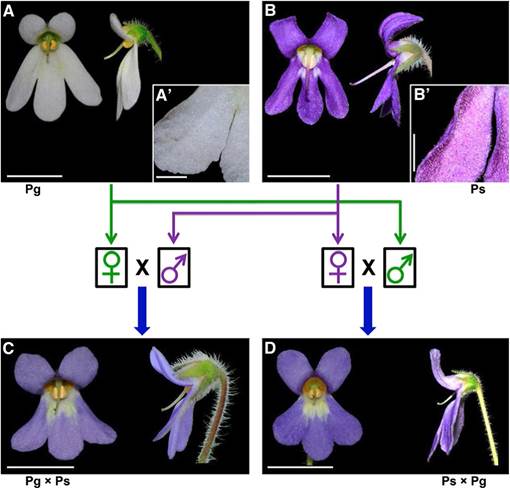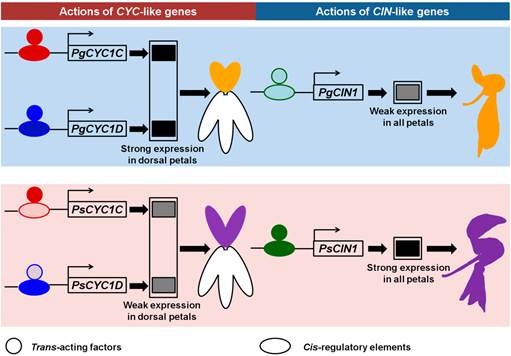Plant Physiology:中科院植物所王印政研究组揭示花对称性形态分化
11月4日,《Plant Physiology》期刊发表中国科学院植物研究所王印政研究组的研究成果,研究揭示了花对称性形态分化的分子调控进化机制。王印政研究组助理研究员杨霞和硕士毕业生赵晓歌为该论文的共同第一作者,王印政研究员为论文通讯作者。
花对称性的进化被广泛认为是被子植物适应辐射的一个重要方面。已有研究显示,花对称性形态分化和多样化主要归因于CYC 类TCP 基因表达模式的时空变化。然而,是否还有其他因子参与其中以及CYC 类基因表达分化的分子调控机制仍然未知。
研究组以苦苣苔科石蝴蝶属植物及其人工杂交F1代为材料,通过功能分析和F1代等位基因特异性表达分析,揭示出CYC 类旁系同源基因的种间表达分化源自截然不同的调控途径,并首次发现CIN 类基因也参与了花对称性的形态分化。
在完成石蝴蝶属(Petrocosmea)的系统发育重建并将其划分为5个支系(A、B、C、D、E)(成果已发表于BMC Plant Biology)之后,研究人员以D和E支系的代表种即光喉石蝴蝶(P. glabristoma)和中华石蝴蝶(P. sinensis)为材料,开展了人工杂交、突变体相关基因的实时荧光定量PCR以及F1代等位基因特异性差异表达分析。结果显示,CYC 类PCYC1C 和PCYC1D 基因特异性控制背部花瓣的大小,CIN1 基因调控其反折程度;两类基因在种间的表达分化和协同作用导致两个种的花部表型变异(图2)。
进一步研究发现,PCYC1C 和PCYC1D 是一对高度冗余的旁系同源基因,不仅在种内的表达模式十分相似,而且在种间的表达分化也高度协调一致。然而,PCYC1C 在种间的表达分化归因于顺式调控的变化,而PCYC1D则主要受反式调控变化影响。这一重要发现表明PCYC1C 和PCYC1D 在功能和表达模式高度冗余的背后隐藏着截然不同的分子调控进化机制,从而对当前分子进化理论中有关重复基因保留机制的假说提出了挑战。

图1.Pg:光喉石蝴蝶(P. glabristoma);Ps:中华石蝴蝶(P. sinensis);Pg×Ps:正交F1代;Ps×Pg:反交F1代

图2.不同的调控变化导致CYC 类和CIN 类TCP 基因的表达分化,进而导致石蝴蝶属两侧对称花(主要是背部花瓣)的形态分化
原文链接:
Distinct Regulatory Changes Underlying Differential expression of TEOSINTE BRANCHED1-CYCLOIDEA-PROLIFERATING CELL FACTOR Genes Associated with Petal Variations in Zygomorphic Flowers ofPetrocosmea spp. of the Family Gesneriaceae
原文摘要:
CYCLOIDEA (CYC)-like genes, belonging to the plant-specific TCP transcription factor family that is named after TEOSINTE BRANCHED1 (TB1) from maize (Zea mays), CYC from Antirrhinum majus, and the PROLIFERATING CELL FACTORS (PCF) from rice (Oryza sativa), have conserved dorsal identity function in patterning floral zygomorphy mainly through specific expression in dorsal petals of a flower. Their expression changes are usually related to morphological diversity of zygomorphic flowers. However, it is still a challenge to elucidate the molecular mechanism underlying their expression differentiation. It is also unknown whetherCINCINNATA (CIN)-like TCP genes, locally controlling cell growth and proliferation, are involved in the evolution of floral zygomorphy. To address these questions, we selected two closely related species, i.e. Petrocosmea glabristoma andPetrocosmea sinensis, with distinct petal morphology to conduct expression, hybridization, mutant, and allele-specific expression analyses. The results show that the size change of the dorsal petals between the two species is mainly mediated by the expression differentiation of CYC1C and CYC1D, while the shape variation of all petals is related to the expression change of CIN1. In reciprocal F1 hybrids, the expression of CYC1C, CYC1D, and CIN1 conforms to an additive inheritance mode, consistent with the petal phenotypes of hybrids. Through allele-specific expression analyses, we find that the expression differentiation of these TCP genes is underlain by distinctly different types of regulatory changes. We suggest that highly redundant paralogs with identical expression patterns and interspecific expression differentiation may be controlled by remarkably different regulatory pathways because natural selection may favor different regulatory modifications rather than coding sequence changes of key developmental genes in generating morphological diversity.
作者:王印政

